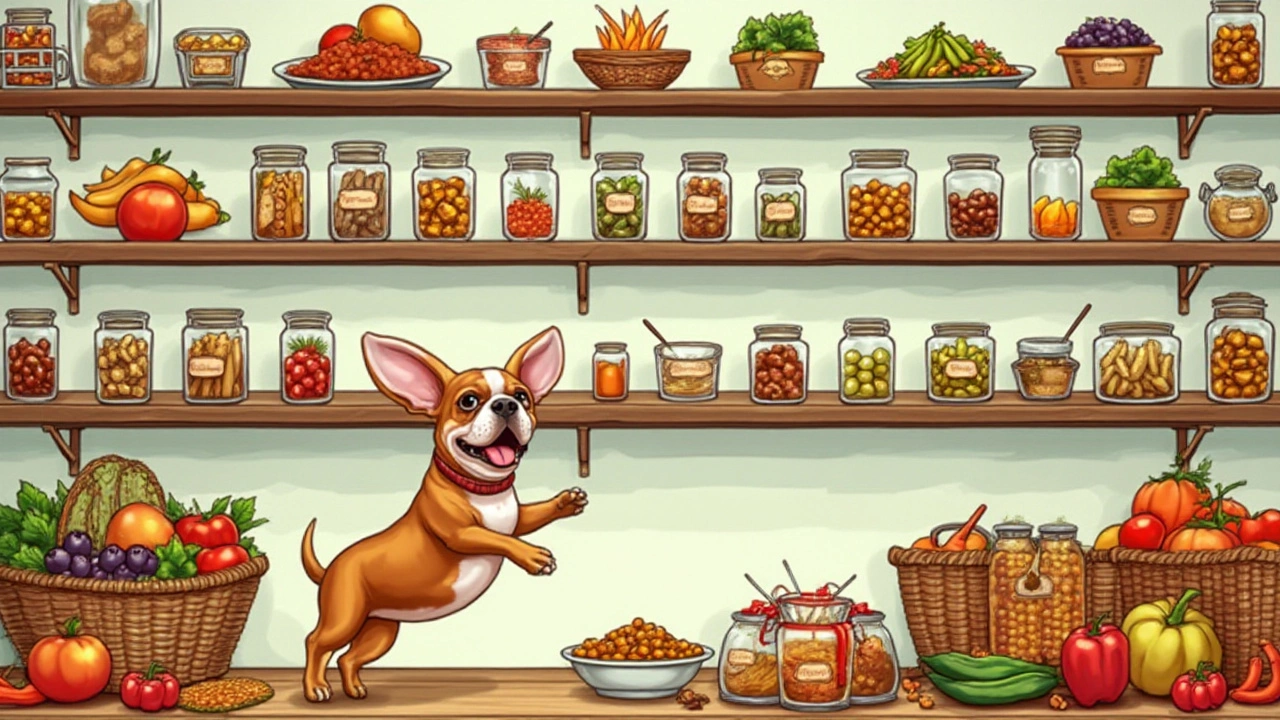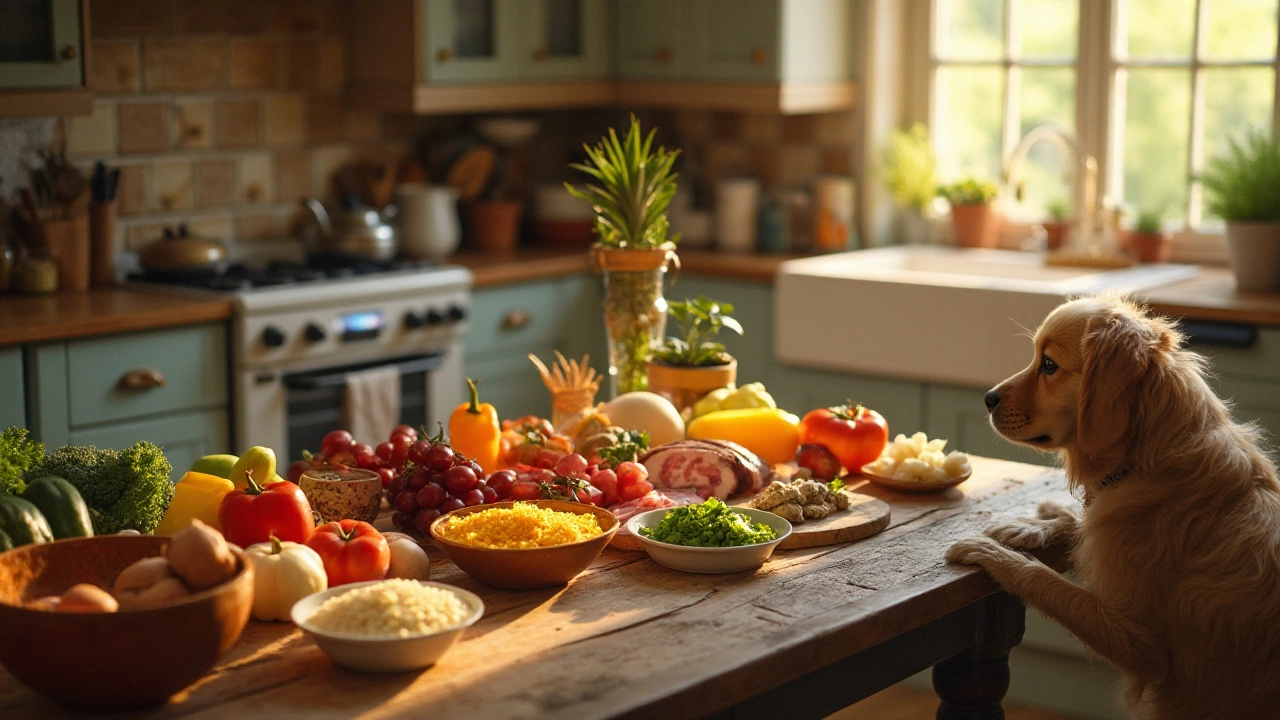Feeding your dog with love doesn’t have to mean spending a fortune on store-bought food. Many pet owners are turning to homemade meals to nourish their canine companions, often finding that it brings more health benefits at a fraction of the cost. But how do you dive into preparing your own budget-friendly dog meals without feeling overwhelmed?
In our guide, we'll break down why real food is a wonderful choice and offer practical tips for planning your pet's diet affordably. With a little knowledge and creativity, feeding your dog homemade meals can be rewarding for both you and your furry friend. Let's uncover the essentials you need, the grocery tips for savvy shopping, and even some easy recipes to start.
- The Benefits of Real Food for Dogs
- Budgeting Basics for Homemade Dog Meals
- Essential Ingredients for a Healthy Dog Diet
- Tips for Cost-Effective Dog Feeding
The Benefits of Real Food for Dogs
Dogs have evolved alongside humans, sharing our homes and even our meals for thousands of years. Their dietary needs, while distinct from ours, benefit greatly from a rich array of natural ingredients. One of the most compelling reasons to feed dogs real food is the remarkable improvement in their overall health and vitality. When you provide your beloved pet with a diet made up of wholesome, unprocessed ingredients, you are effectively reducing the intake of unnecessary fillers and additives that often lurk in commercial pet foods. This means their bodies are absorbing nutrients closer to what nature intended, promoting healthier skin, shinier coats, and boosted energy levels.
The benefits extend beyond just physical appearance. Dogs consuming a real food diet frequently enjoy enhanced digestion, leading to fewer gastrointestinal issues, less bloating, and a more regular bowel movement schedule. This is primarily due to the presence of natural fibers and balanced proteins that are much easier on a dog's stomach. Notably, when dogs eat meals rich in vegetables, lean proteins, and whole grains, many pet owners observe an improvement in the overall demeanor and behavior of their pets. This is often attributed to better nutrient absorption, which supports cognitive health, potentially reducing anxiety and hyperactivity.
Additionally, crafting meals for your dog at home allows you to tailor their diet according to their specific health needs. Perhaps your dog has allergies or sensitivities to certain ingredients found in mass-produced dog foods. By deciding precisely what goes into their bowl, you gain control over potential allergens. This level of customization ensures your pet's dietary requirements are met, leading to a more content and comfortable furry friend.
Interestingly, the switch to a real food diet can also have lasting effects on canine longevity. Studies have shown that a natural diet can contribute to extending a dog's lifespan by supporting a stronger immune system and improving organ function. According to Dr. Karen Becker, a proactive and integrative wellness veterinarian, "Dogs thrive on fresh, living foods. With the right balance, they can lead healthier and happier lives."
Moreover, the transition to homemade meals doesn't mean sacrificing convenience. Many ingredients used in preparing dog food are often leftovers or parts of our meals that would otherwise be discarded. By incorporating these food items into your dog's diet, you're not only reducing waste but also saving money. Imagine using just a few vegetables, grains, and a bit of protein to whip up a nutritious dog meal; it’s more attainable than it seems.
A deciding factor for many is the newfound transparency and peace of mind that comes with knowing exactly what their pet is consuming. Unlike packaged foods, where ingredients can sound like a chemist's paradise, real food diets typically include recognizable items. This simplicity can be a powerful motivator for those concerned with processed foods and their long-term effects.
Finally, feeding your dog real food on a budget ensures that they still receive the same love and care you would provide them with store-bought alternatives. With some planning, you can turn meal prep into a fun and rewarding experience for both you and your pup. After all, seeing their wagging tails and happy, pleading eyes is worth the slight extra effort in the kitchen. Ultimately, your pet's health and happiness can be the greatest payoff.
Budgeting Basics for Homemade Dog Meals
Incorporating homemade meals into your dog's diet doesn't have to be a daunting task. The key to sticking to a budget while feeding your pup real food lies in planning and resourcefulness. Begin by researching your dog’s dietary needs based on their breed, size, age, and any health issues they might have. Knowing the nutritional essentials like proteins, carbohydrates, fats, vitamins, and minerals is crucial for creating a balanced meal that supports their overall health. Setting a weekly or monthly food budget can help you stay organized, and it will prevent surprise expenses from popping up unannounced.
To make the most out of your budget, consider buying ingredients in bulk, especially staples like rice, oats, canned pumpkin, and sweet potatoes, which can form the basis of many meals. These ingredients are not only nutritious but also economical when purchased in larger quantities. Seasonal vegetables are another great addition, often available at a lower price point than other out-of-season produce. If you have storage space, consider stocking up during sales or at farmers' markets where you might find fresh produce at discounted rates. Some pet owners collaborate with local farmers or butcher shops to obtain meat cuts at reduced prices. As with any meal preparation, ensuring quality ingredients doesn't mean they have to be expensive.
Another effective strategy is meal prepping, which saves both money and time. Cooking a batch of meals at once and storing them in the freezer can significantly cut down on daily prep time and help manage resources efficiently. A typical meal could include a protein like chicken or beef, a carbohydrate such as brown rice, and a mix of vegetables, creating a balanced diet that supports your dog’s health. Speaking of protein, creative substitutions like using liver or fish, which are packed with nutrients, are often cost-effective. This way, you craft meals that not only delight your furry friend but also align with your financial constraints.
Building a Budget-Friendly Meal Plan
Creating a meal plan dedicated to budget-friendly pet meals ensures you're using your resources wisely. Begin with a list of must-have nutrients, then allocate a portion of your budget for each component. You may want to alternate protein sources throughout the week to keep things interesting for your dog while capitalizing on seasonal discounts. Additionally, keeping a chart of meal costs can help you track spending and adjust recipes as needed to minimize expenses. The flexibility of homemade meals allows you to incorporate a variety of affordable, nutritious options!
In an article on pet nutrition, veterinarian Dr. Karen Becker notes, ‘When making homemade dog food, strive for variety to ensure a range of nutrients, which is easier on your wallet and healthier for your pet.’
Don't hesitate to explore online communities or social media groups where pet owners share tips and recipes. These platforms can be a treasure trove of advice, and frequently, someone will have already found innovative solutions to the challenges of homemade dog food preparation. Whether you're a novice or experienced in the kitchen, remember that a little creativity can go a long way, supporting your mission to provide delicious, budget-friendly meals for your beloved pet. With these budgeting basics in hand, feeding your dog real food on a budget can become a hassle-free reality!

Essential Ingredients for a Healthy Dog Diet
When thinking about crafting a balanced diet for your dog, it's crucial to understand both nutritional needs and cost-effective options. Dogs, much like humans, require a mix of proteins, carbohydrates, fats, vitamins, and minerals. Meat, for instance, is a staple in any canine diet as it provides high-quality protein along with various nutrients that support muscle health and energy levels. Including a variety of meats like chicken, turkey, and beef ensures they get diverse amino acids. Don’t shy away from buying meat in bulk when you find deals at local markets.
Equally important are carbohydrates, which can come from vegetables like sweet potatoes, carrots, and peas. These veggies are not only affordable but also packed with fiber, promoting a healthy digestive system for your pet. Incorporate them in moderate portions to help regulate your dog's energy without adding excessive calories. It's vital to steam or boil these veggies, as this makes them easier for your dog to digest and absorb all the essential nutrients.
Fats are another essential component, necessary for maintaining healthy skin and coat. Healthy oils such as fish oil, which contains omega-3 fatty acids, can be great additions. While it might sound like a luxury item, small bottles last long and require minimal daily usage. Often you’ll find purchasing these items from hobbyist fishing outlets offers better prices than standard pet shops. No doggie diet is complete without considering these cornerstones of healthy feeding.
“Dogs should be fed diets that match their evolutionary makeup, which means a focus on animal-derived proteins, complemented by vegetables and other whole foods.” — Dr. Karen Becker, a renowned integrative wellness veterinarian.
Let's not forget grains, which are sometimes overlooked in dog's meals but necessary unless your pet has specific dietary restrictions. Brown rice and oats are inexpensive, long-lasting, and easy to cook. They provide a good source of vitamins like B1, B6, and E, which are essential for immune function and cellular protection. To balance the budget, opt for big bags and keep them stored in airtight containers to maintain their freshness over time.
Lastly, never underestimate the role of supplements when feeding homemade dog diets. Calcium and phosphorus support bone health and can be derived from ground eggshells and bones respectively. Although it may sound unconventional, eggshells can be effortlessly rinsed, dried, and crushed into a fine powder to sprinkle over meals. This little trick provides necessary minerals without the cost.
With a perfect blend of proteins, carbs, fats, and grains from your kitchen, creating a dog's meal becomes an act of love that doesn’t leech your wallet dry. Instead of feeling bound to commercial offerings, these core elements give you freedom to explore and adapt based on your dog’s preferences and needs. This way, the joy of mealtime is shared between the two of you—a gesture of care from bowl to belly.
Tips for Cost-Effective Dog Feeding
Feeding your dog nutritious food without breaking the bank requires a bit of creativity and awareness of how to source ingredients affordably. One of the easiest ways to start is by evaluating your own grocery list. Plenty of foods you already buy can double as homemade dog diet components. For instance, purchasing ingredients in bulk is not only cost-effective but also ensures steady supplies. Staples like brown rice, oats, and sweet potatoes are economical and can form the base of many dog meals. Purchasing these staples in larger quantities often reduces the cost per unit, making them a smart choice for diligent pet owners.
A surprising tip is to take full advantage of seasonal sales and incorporate these into your meal planning. Many meats and vegetables go on sale depending on the time of year, so aligning your dog's diet with what's both abundant and discounted can help your wallet significantly. Canning and freezing excess fresh produce can be another effective way to save money while maintaining a diverse diet for your dog. By preparing and storing these staples yourself, you avoid the markups associated with pre-packaged, dog-specific food products while ensuring high-quality ingredients.
"The best diet for your dog doesn't have to be the most expensive one," notes renowned veterinarian Dr. Lisa Freeman. "It's about balance and knowing where to source quality ingredients cleverly."
Engaging with local butchers or farmers' markets is also a valuable strategy for acquiring protein sources at a lower cost. Many butchers have scraps of meat they are willing to sell or even give away, which can be ideal for a budget-friendly pet meal. Such options provide lean cuts with fewer fillers compared to standard dog food. In addition, asking local farmers about blemished produce they might sell at discounted rates not only cuts costs but also supports local businesses, creating a mutually beneficial relationship.
Additionally, making use of every part of the produce and meat you purchase is an art worth mastering. Cooking with bones can be a great starting point for a nourishing broth, packed with minerals essential for your dog’s health. Just remember to always strain the broth to remove any fragments, as cooked bones are not safe for canine consumption. The art of frugality with vegetables can range from utilizing carrot tops in broths to incorporating leftover vegetable scraps into a hearty stew. All these little tricks contribute to a sustainable practice that reflects not just on your savings but also on a healthier environment.
Being creative with your sources doesn’t end with just food shopping habits. Sometimes planting your own mini-garden can reduce costs significantly in the long run. Herbs like parsley or even small root vegetables can be grown in window boxes or small patches of your yard, providing a fresh supply of ingredients that benefit not only your dog but your meals as well. Knowing exactly what goes into those foods provides peace of mind in terms of food safety and quality. It's about creating a little harmony between your needs and your pet's, where both parties can thrive.
Finally, collaboration with fellow pet owners can lead to shared tips and even ingredient swapping. Pet owner groups, often found through community boards or social media platforms, can be an untapped resource of knowledge and camaraderie. Maybe someone has a connection to a source of salmon or chicken, which can be quite expensive otherwise, or you can connect with someone who’s discovered a cheap but reliable supply chain for grains. This informal network of resources can be crucial for navigating the sometimes expensive journey of feeding your dog well without sacrificing quality.







